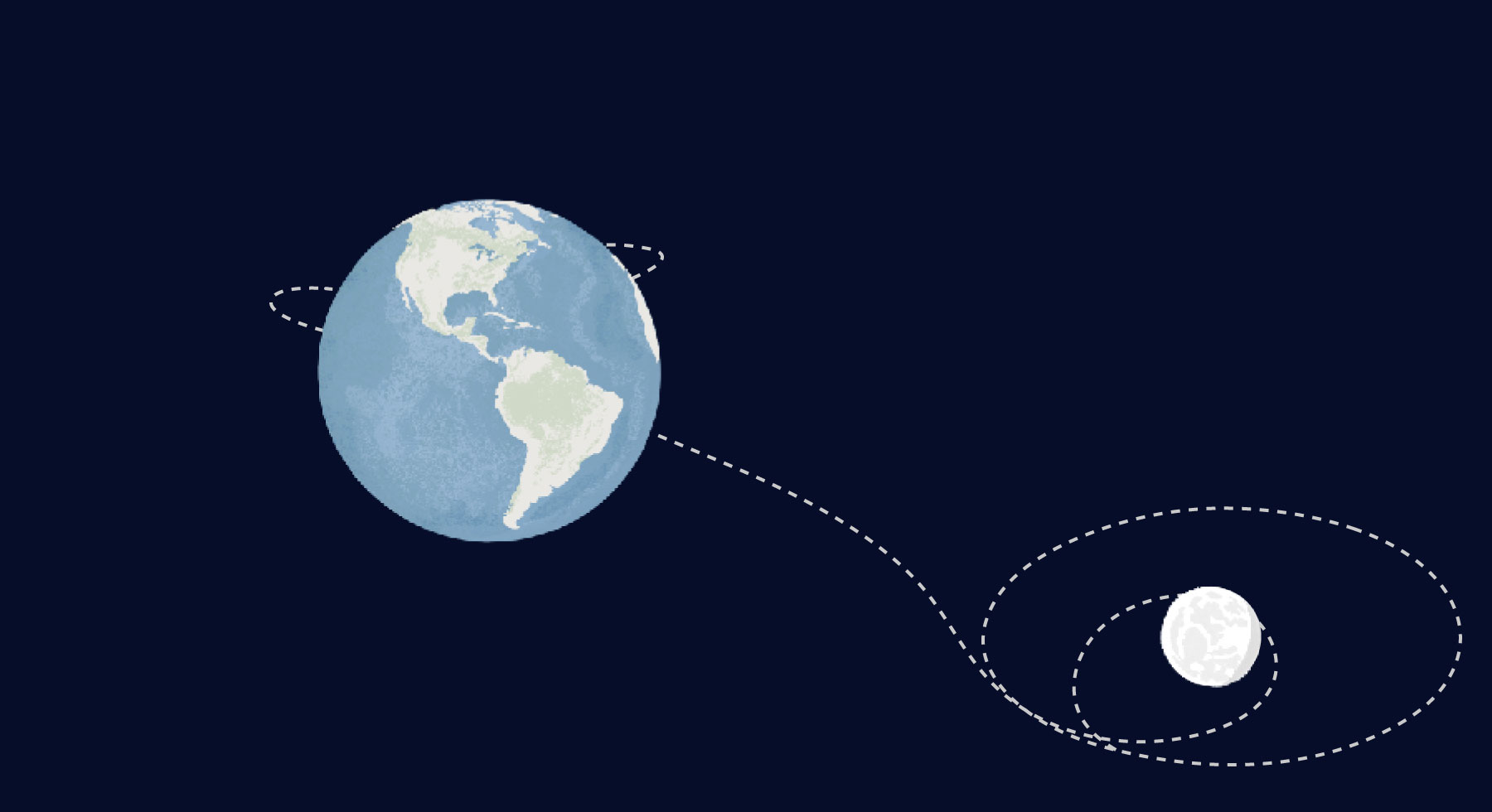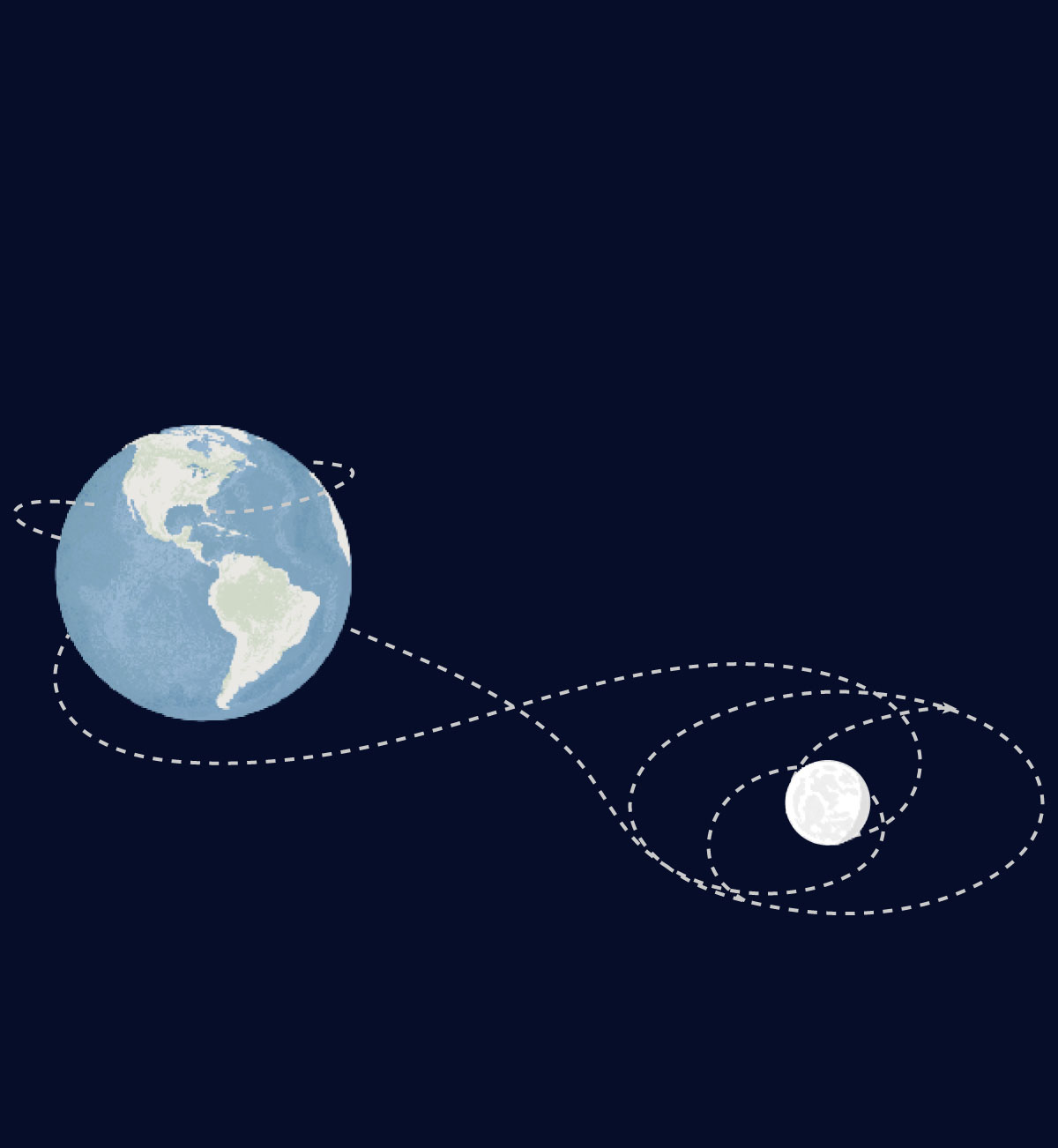
The Return
Orbiting the Moon
The Outset
9 to 19 days
8 to 14 days
6 to 19 days
The first leg of the journey will focus on getting the spacecraft from Earth to the moon’s orbit.
The Orion will set its sight on Earth, completing a 1.3-million-mile journey.
The Orion will enter the moon’s orbit and perform half or one and a half revolutions.
1. Launch
10. Splash Down
6. Moon Orbit
2. Rocket Jettison
The spacecraft will fall into the Pacific Ocean to be retrieved by a nearby U.S. Navy recovery ship.
NASA will try a new reentry maneuver called a “skip entry” which could make for smoother, safer return rides for future astronauts.
The Space Launch System (SLS) rocket carrying the Orion spacecraft blasts off from Kennedy Space Center in Florida.
Orion will pass the moon as close as 60 nautical miles before traveling as far out as 38,000
nautical miles for its distant retrograde orbit.
38,000 nautical miles is about 15 and a half times as long as the distance between NYC and LA.
Distant Retrograde Orbit
9. Test Crew Component
SLS rocket boosters, fairings (nose cone), launch abort system and main engine fall off.
5. Nearing the Moon’s Orbit
The orbit is “distant” because it’s at a high altitude from the moon. It’s “retrograde” because Orion will travel around the moon opposite the direction the moon travels around Earth.
7. Return Initiated
Orion’s crew module separates from its service module for reentry.
Orion makes adjustments as needed to enter a distant retrograde orbit around the moon.
Orion prepares for return, using its service module engine’s “return powered flyby” burn.
3. Earth Orbit
Orion enters Earth’s orbit. Systems checked and solar panels adjusted.
Cubesats
Along the way, 10 cubesats are deployed.
8. Toward Earth
4. Propulsion Stage
The Cubesats, no bigger than a shoebox, are nano-satellites that will conduct tests in space, such as looking for water on the moon, to aid future missions.
Engine burns as needed to aim for Earth.
An engine fires to push the Orion toward the moon’s orbit. Afterwards, the engine drops off.

Orbiting the Moon
The Return
The Outset
8 to 14 days
9 to 19 days
6 to 19 days
The first leg of the journey will focus on getting the spacecraft from Earth to the moon’s orbit.
The Orion will enter the moon’s orbit and perform half or one and a half revolutions.
The Orion will set its sight on Earth, completing a 1.3-million-mile journey from start to finish.
6. Moon Orbit
7. Return Initiated
8. Toward Earth
1. Launch
2. Rocket Jettison
38,000 nautical miles is about 15 and a half times as long as the distance between NYC and LA.
Orion prepares for return, using its service module engine’s “return powered flyby” burn.
Orion will pass the moon as close as 60 nautical miles before traveling as far out as 38,000 nautical miles for its distant retrograde orbit.
Engine burns as needed to aim for Earth.
The Space Launch System (SLS) rocket carrying the Orion spacecraft blasts off from Kennedy Space Center in Florida.
SLS rocket boosters, fairings (nose cone), launch abort system and main engine fall off.
Cubesats
9. Test Crew Component
3. Earth Orbit
The Cubesats, no bigger than a shoebox, are nano-satellites that will conduct tests in space, such as looking for water on the moon, to aid future missions.
Orion’s crew module separates from its service module for reentry.
Orion enters Earth’s orbit. Systems checked and solar panels adjusted.
Along the way, 10 cubesats are deployed.
Distant Retrograde Orbit
10. Splash Down
4. Propulsion Stage
5. Nearing the Moon’s Orbit
NASA will try a new reentry maneuver called a “skip entry” which could make for smoother, safer return rides for future astronauts.
The spacecraft will fall into the Pacific Ocean to be retrieved by a nearby U.S. Navy recovery ship.
An engine fires to push the Orion toward the moon’s orbit. Afterwards, the engine drops off.
Orion makes adjustments as needed to enter a distant retrograde orbit around the moon.

Moon Orbit
The Outset
The Return
8 to 14 days
9 to 19 days
6 to 19 days
The Orion will set its sight on Earth, completing a 1.3-million-mile journey.
The Orion will enter the moon’s orbit and perform half or one and a half revolutions.
The first leg of the journey will focus on getting the spacecraft from Earth to the moon’s orbit.
Return Initiated
Moon Orbit
Launch
1
Orion prepares for return, using its service module engine’s “return powered flyby” burn.
The Space Launch System (SLS) rocket carrying the Orion spacecraft blasts off from Kennedy Space Center in Florida.
Orion will pass the moon as close as 60 nautical miles before traveling as far out as 38,000
nautical miles for its distant retrograde orbit.
38,000 nautical miles is about 15 and a half times as long as the distance between NYC and LA.
Toward Earth
2
Rocket Jettison
Engine burns as needed to aim for Earth.
SLS rocket boosters, fairings (nose cone), launch abort system and main engine fall off.
During reentry, NASA will try a new “skip entry” maneuver, which could mean smoother, safer return rides for future astronauts.
2
Distant Retrograde Orbit
1
Along the way, 10 cubesats are deployed.
5
3
4
Cubesats
Earth Orbit
3
Test Crew Component
The Cubesats, no bigger than a shoebox, are nano-satellites that will conduct tests in space, such as looking for water on the moon, to aid future missions.
Orion enters Earth’s orbit. Systems check and solar panels adjusted.
Orion’s crew module separates from its service module for reentry.
Propulsion Stage
4
Splash Down
An engine fires to push the spacecraft toward the moon’s orbit. Afterwards, the engine drops off.
Distant Retrograde Orbit
The spacecraft will fall into the Pacific Ocean to be retrieved by a nearby U.S. Navy recovery ship.
The orbit is “distant” because it’s at a high altitude from the moon. It’s “retrograde” because Orion will travel around the moon opposite the direction the moon travels around Earth.
Nearing the Moon’s Orbit
5
Orion makes adjustments as needed to enter a distant retrograde orbit around the moon.